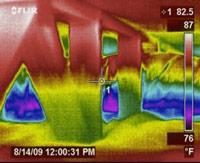Envelope Thermal Failures Due to Wind Washing in Two-Story Homes

This paper examines heat loss/heat gain mechanisms which occur in many two-story residences during hot and humid weather, when air coming either from attic spaces located above first-story sections of the house or air directly from outdoors, can flow into floor cavities positioned between the first and second stories of the house. Mechanisms which contribute to energy losses are examined and consideration is given to wind-driven, thermal buoyancy-driven, and mechanically-driven air transport. Heat and moisture flow into floor cavities during hot summer afternoons and cold winter mornings in particular, are discussed in the context of factors such as roof type/color, radiant barriers, prevailing wind direction, complimentary holes, leak pathways to indoors, and attic venting that affect attic temperature and sensible and latent heat transfer into the conditioned space. Field test data from 32 homes (including blower door, duct leakage, return leak fraction, tracer gas decay air infiltration, pressure mapping, and AC performance testing) and measured energy savings from repair in 6 homes are provided. Case studies that are presented here exemplify both the repair techniques and characterize the factors which cause wind washing. Furthermore this paper examines the relationship between wind washing and duct leakage.


Add comment
Log in to post comments